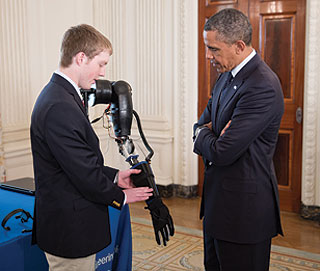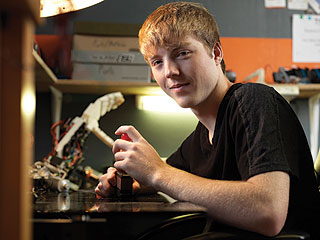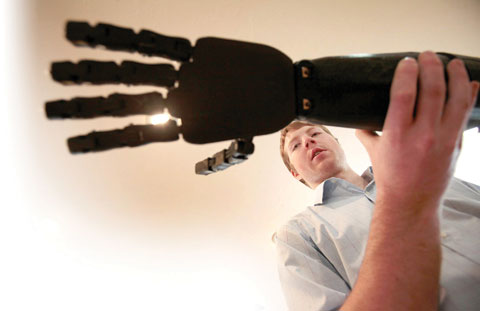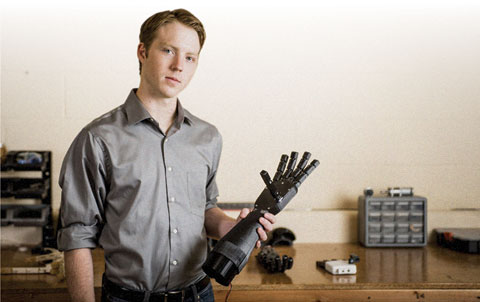 |
||||||||||||
|
January/February 2016
BY CLAUDIA GARY The need for prosthetics and related services among veterans has increased by more than 70 percent since 2000, according to the VA’s Office of Research & Development. While there have been considerable advances in developing prosthetics to replicate the function of hands and arms, most of them come with a price tag that can make them virtually unaffordable outside of the VA. One of the most advanced prosthetic arms—approved in 2014 and expected to be available in the VA health system—was developed by DEKA Integrated Solutions Corporation with $40 million in funding from the Defense Advanced Research Projects Agency (DARPA). Throughout history, though, there have been individuals who reimagine cumbersome solutions in an elegant way. Easton LaChappelle, now 20, while in his teens invented a prosthetic arm that can be produced for less than $1,000 using a 3D printer. Although LaChappelle had always enjoyed taking apart gadgets and creating new ones, it was a chance meeting six years ago with a seven-year-old girl whose prosthetic arm had cost $80,000 that spurred his humanitarian effort to develop what he calls “extreme technology for an affordable price.”
“For my life to actually mean something at this age is rewarding,” he said in an interview, emphasizing that “you don’t have to learn in an education environment. I grew up in a very small town in Colorado with hardly any resources, but I had enough resources that I could teach myself what I needed to learn to be able to turn ideas into reality.” He enjoys “putting these concepts into young minds and inspiring them to find their passion. You can make your own dream come true in today’s world. And hopefully we can do that with the Robo Arm and a lot of these technologies that we’re developing.” LaChappelle has made his Robo Arm available through a Creative Commons license through his company’s website so that anyone who has access to a 3D printer can print out the parts and assemble them. The license currently prohibits any commercial uses for the Robo Arm. “It also states that we are the creator of it,” LaChappelle said, “so for anything you do, you have to credit us eventually, although you can change it and adapt it.” The goal is not to compete with existing prosthetics manufacturers, but rather to improve what they can do and what they can offer. The website is theroboarm.com/#about
After finishing high school, Easton LaChappelle chose to postpone or skip college rather than lose time from his work. He started a company, Unlimited Tomorrow, with minimal funds and a GoFundMe campaign. More recently, investment from motivational speaker Tony Robbins enabled Unlimited Tomorrow to move to larger quarters and expand its work. LaChappelle described some basics: “With the Robo Arm, there are really two pieces of the puzzle: the physical side—the actual robotic arm, which is something I’ve been working on for six years now—and the control system, which has been lacking and is still lacking in most industrial control systems, advanced robots, and heavy machinery. The control systems are lacking in an advanced human interface to actually merge man and machine. We have to make this seamless. And for that, I’ve ventured into a few different technologies, such as brain-wave technology and also advanced muscle control. For me, the most effective solution is actually a hybrid of the two.” The Robo Arm is totally modular, he said, and can be customized depending on the extent of the limb that needs replacement. “If I’m just missing from my forearm to my fingertips, I would just need a robotic hand, which has ‘open,’ ‘close,’ and some other movements. But if I’m missing up to my shoulder, that adds six motions I have to control. To be able to control those six motions, you can’t just do it with a single muscle sensor. You have to introduce other sensors and other inputs for the user. So that’s when the brain-wave technology really takes hold: when you start getting into multiple movements. And that’s when muscle sensors also come in, with a hybrid system, to make it as natural as possible for the individual.”
If an individual can create this, what does it take in order to put it to use? The next step is to take the robotic arm and controller to a prosthetist for fitting, and to go through calibration and training. “Honestly, I think the hardest part of all of this is combining the essentially robotic device to your existing socket,” LaChappelle said. “And that’s something that we are hoping to make universal as well,” starting with a “quick 3D scan of the socket.” All in all, he said, the Robo Arm prosthetic has the potential to be “a tremendous tool at a fraction of the cost. It’s open-source, it’s easy to create, and if anything breaks, it’s a $2 part versus weeks of time and hundreds of dollars. So, we’re trying to go forward with that philosophy.” One priority for LaChappelle is to avoid the need for surgery. “Everything is completely external, which is definitely key for me.” Although other brain-wave systems, including one being researched at Johns Hopkins University, are promising, they involve surgery that is invasive, dangerous, and costly. One thing that will help LaChappelle continue his humanitarian work is the structure of his business. “We have another division of the company that is focused on industrial control systems,” he said. “You can think of it as the next generation of joysticks. For backhoes, mining equipment, and industrial robots, human controllers would use this.”
We also spoke to Dr. Joseph A. Miller, the VA’s program director for orthotics and prosthetics clinical services, to get his view of the field’s challenges and prospects. “Within the VA we have a professional workforce of orthotists and prosthetists at seventy-nine sites around the country,” Miller said. “For VA, workforce training and education on the new technologies is always an issue. We are always looking for ways to work with the manufacturers to provide that training and be able to improve our skill set.” Also, he said, “there’s a limited number of patients whose upper extremities would qualify for these new and advanced prosthetics,” which limits the opportunities to develop expertise. “And that’s true for both the private sector and the VA.” Meanwhile, he said, thanks to the VA’s integration of services, “my prosthetic staff has access to physicians and rehab therapists who may be just down a hallway, whereas in the private sector there is segmented care.” Miller sees advantages in implanted systems but said that following surgery, “there could be some issues beyond the typical rejection of devices being implanted. When you look at some of these systems, care and maintenance are going to be a big issue. And although the prosthetist is going to be responsible for the prosthesis, who is going to be responsible for those implanted electrodes? “I think the future is still pretty wide open,” he said. “We are seeing a lot of dollars that are provided from the VA and the Department of Defense to fund some of these advanced prosthetic devices such as the DEKA arm. So there is a new robust technology. What’s lacking right now is still the control mechanism to be able to have the patient operate that in an intuitive way; but there is work being done in those areas. The VA is conducting a take-home study with several veterans regarding the DEKA arm. That study will give us some input into who is the proper candidate for these types of technologies. I wouldn’t anticipate any [results] probably for a couple of years. “I think overall the VA is definitely leading in the research and development area,” he said, “and due to the cost of some of these devices, the VA is probably going to be leading in the transition process in bringing out these things when they start to come to market.”
Easton LaChappelle described several challenges he faces in his work, starting with the Food and Drug Administration. “In some cases the FDA can be really good, and in some cases it can slow development, slow technology,” he said. Being able to market the Robo Arm as a prosthesis has “been a big hurdle for us,” he said. “We’re just starting to get around it by working with other companies that have infrastructure and money to be able to facilitate some of the regulations.” Since getting FDA approval is such a costly process, he said, “For me—starting off so young, and being a small startup company—that wasn’t an option. I figured there had to be a better way. So that’s one of the reasons we made this open-source. Because it’s open-source, and the license states that anyone can use this for any application they can dream of, [the users] become liable for what they do—which is really the key. So I make it open-source, they download the files, they make it themselves, and they use it for whatever application they want.” However, he said, “We are just starting to work [through nonprofits] with the first few individuals in the U.S. who will be fitted and using these every day.” In addition, he said, “I’ve been working with a few nonprofits for third world countries, which are taking my designs and going overseas and printing them. We are looking at adopting a business model for international and global use.” In the technology itself, LaChappelle said, “there are very few barriers, but one that I face almost on a daily basis is trying to get the right materials to use with the 3D printer.” Unlimited Tomorrow is working with other companies to make custom materials, such as a carbon fiber-infused ABS plastic, which is extremely strong; and materials that have biocompatibility so that they can be in contact with the skin. The result, he said, is “so hard and compact that you don’t have to worry about falling down and breaking anything on the Robo Arm. You could throw it across the room and pick it up and it would work.” As for working with prosthetists, he said, “We’ve talked with a few of them, and it’s either that they are really excited about this technology, or else they are almost leery of it, because it’s so software-based. Their industry hasn’t seen change in the past thirty years, and now there is a change.” Still, he said, the basic process of fitting a prosthetic to an amputee will not change much. And even though the control technology is new, he makes it sound easy: “You’ll be working with a brain-wave sensor to control the hands, and that will become an everyday task—fitting a brain-wave sensor to a person, looking at the software, going through and calibrating it. That’s something that’s almost science fiction to a lot of prosthetists. So we’re starting to prepare a training process. “We’re trying to do this right, from the start, so that no one gets scared or wary of the technology. That will be good for everybody.”
|
||||||||||||
|
|
||||||||||||
|
||||||||||||
8719 Colesville Road, Suite 100, Silver Spring. MD 20910 | www.vva.org | contact us |
||||||||||||






















 Three years ago the invention earned him a trip to the third annual White House Science Fair, where President Obama was photographed shaking hands with LaChappelle’s robotic arm. Since then, LaChappelle has worked on NASA’s Robonaut program, given a TEDx talk, and spoken around the world at universities and corporate events, as well as to schoolchildren.
Three years ago the invention earned him a trip to the third annual White House Science Fair, where President Obama was photographed shaking hands with LaChappelle’s robotic arm. Since then, LaChappelle has worked on NASA’s Robonaut program, given a TEDx talk, and spoken around the world at universities and corporate events, as well as to schoolchildren. What makes LaChappelle’s Robo Arm different? “Definitely, number one, the cost,” he said. “What you get for that cost [well under $1,000] is tremendous; it’s comparable to one of the most advanced robotic arms out there—the Luke Arm (named after Luke Skywalker), a product of DEKA, which is funded by the government. It’s cool looking and really advanced, but the price tag is outrageous—it’s hundreds of thousands of dollars—and it’s not publicly available yet.”
What makes LaChappelle’s Robo Arm different? “Definitely, number one, the cost,” he said. “What you get for that cost [well under $1,000] is tremendous; it’s comparable to one of the most advanced robotic arms out there—the Luke Arm (named after Luke Skywalker), a product of DEKA, which is funded by the government. It’s cool looking and really advanced, but the price tag is outrageous—it’s hundreds of thousands of dollars—and it’s not publicly available yet.”
